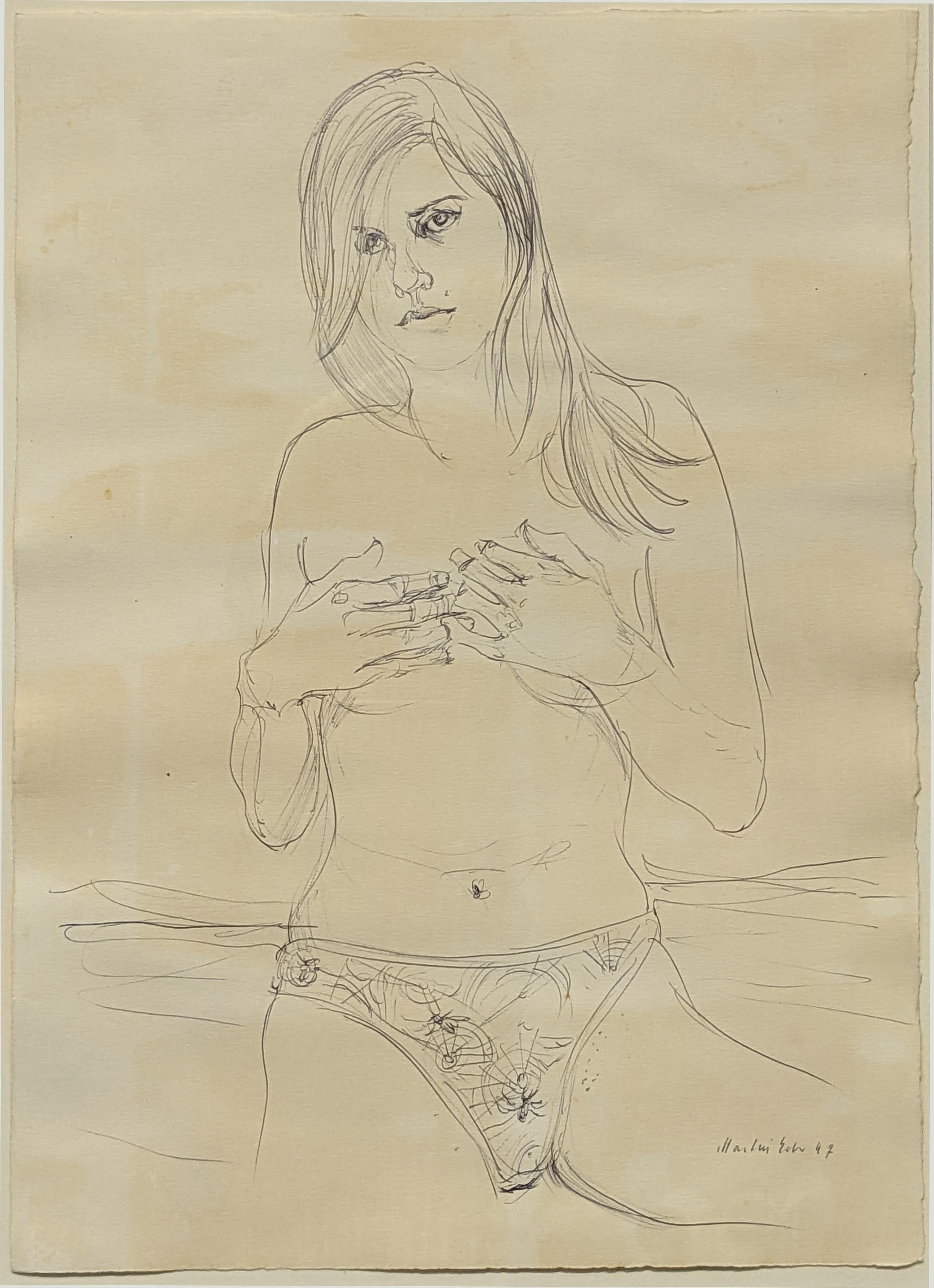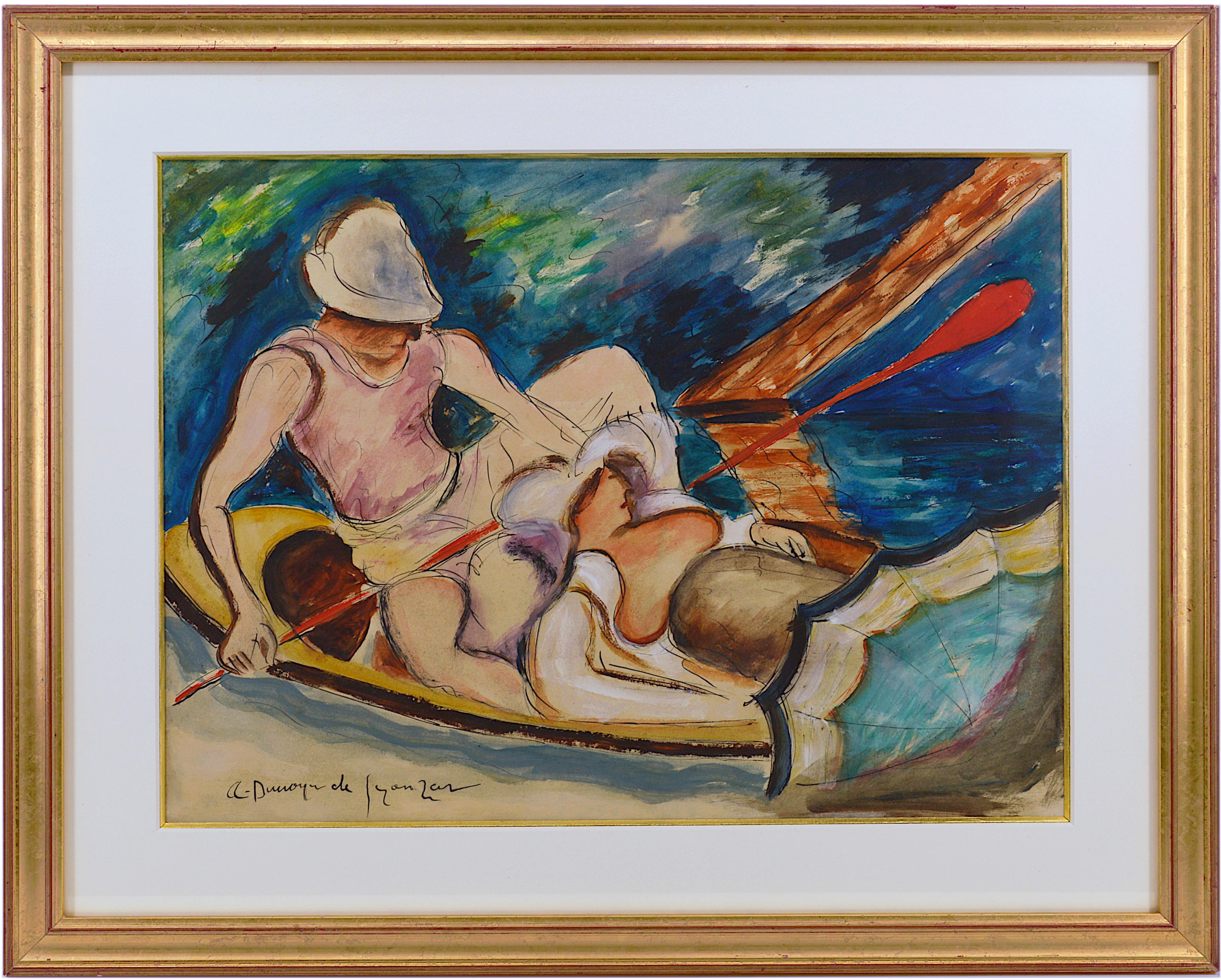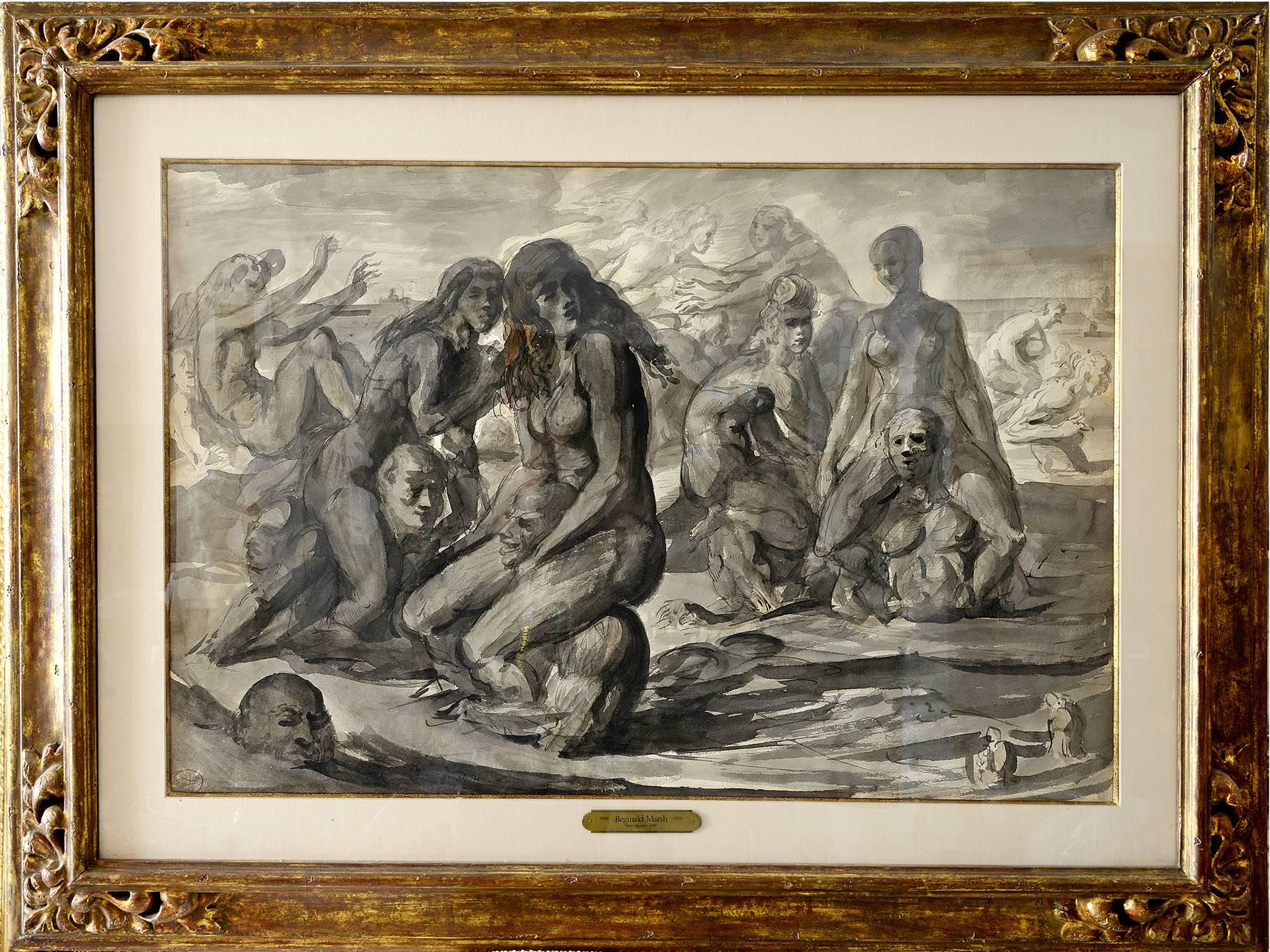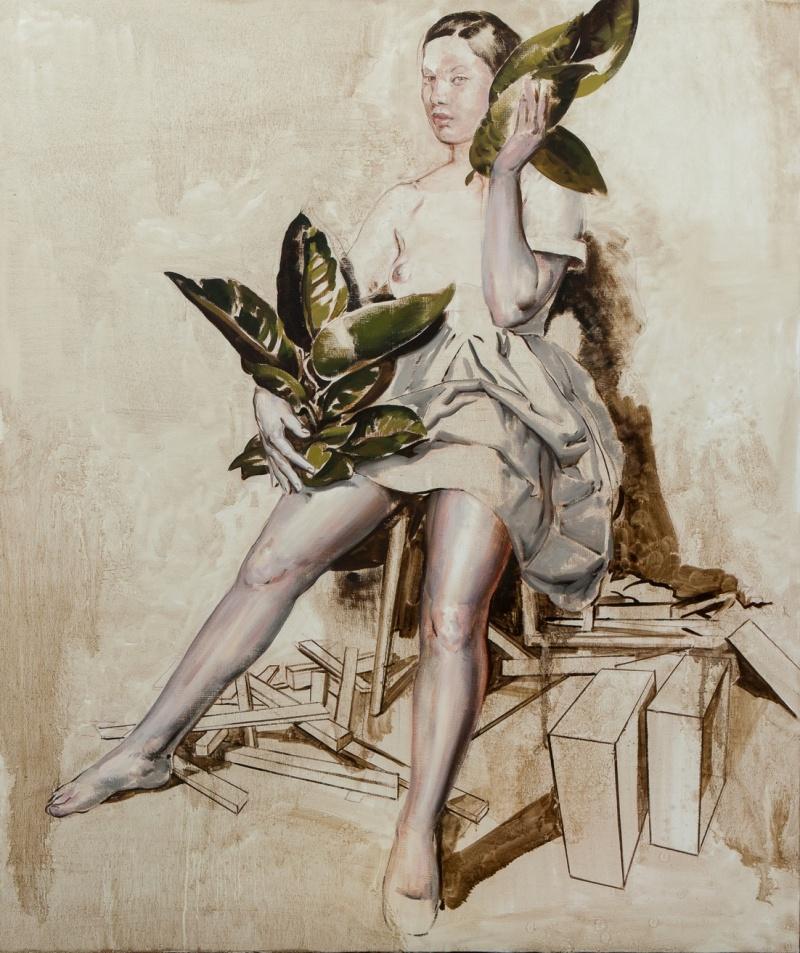Items Similar to Rare Rodin Watercolour & Pencil on Paper of a Seated Nude - The Cambodian Dancer
Want more images or videos?
Request additional images or videos from the seller
1 of 8
Auguste RodinRare Rodin Watercolour & Pencil on Paper of a Seated Nude - The Cambodian Dancer1898
1898
About the Item
Auguste RODIN (1840-1917)
Seated Nude, Cambodian Dancer
c. 1898 - 1900
Pencil and watercolour
11.5 x 9.3 inches;
25 x 20.5 inches, inc. frame
Provenance:
Christie's South Kensington: Wednesday, November 28, 2007
"It's very simple. My drawings are the key of my art."
Rodin was an extraordinary creative artist and a prolific worker. After attending the “Petite École”, he worked in the studio of the ornamentalist Albert-Ernest Carrier-Belleuse, first in Paris, then in Brussels, where his skill in handling decorative subjects fashionable in the 18th century became apparent. His discovery of Michelangelo, during a visit to Italy in 1875-76, was a decisive moment in his career. Rodin would, in turn, break new ground in sculpture, paving the way for 20th-century art, by introducing methods and techniques that were central to his own artistic aesthetics.
In 1906, King Sisowath of Cambodia visited France on an official state visit. It was on this visit that Rodin discovered the dancers of the Cambodian Royal Ballet and was inspired to draw and paint them over 150 times.
They made a deep impression on the artist, as he confided to Georges Bourdon, in an article for the newspaper Le Figaro on 1 August 1906: “There is an extraordinary beauty, a perfect beauty, about these slow, monotonous dances, which follow the pulsating rhythm of the music… [The Cambodians] have taught me movements I had never come across anywhere before…”
Originally seeing them in Paris he left everything suddenly to follow the dancers of the royal ballet to Marseille, from where they would embark on their return to Cambodia.
In just one week, he made about one hundred and fifty drawings, re-transcribing or interpreting the ballet poses, with an obvious fascination for the arms and hands of the dancers. These drawings were later highlighted with watercolour, creating coloured harmonies of a rare refinement.
The first performance of the Cambodian Royal Ballet took place in the context of the Colonial Exhibition in Marseille. Sisowath 1st had just been crowned King of Cambodia when he undertook the first trip ever to be made by a Cambodian sovereign to France, which had controlled Cambodia since June 1884. This official visit occurred at the height of French colonial expansion. Previously, the Universal Exhibition of 1900 had attracted 48 million visitors! The organisers realised what a tremendous impact this event made on the public, and it was soon adopted as the main tool for colonial propaganda. At the exhibition in Marseilles, the area devoted to Indochina was the largest of the seven sections.
When Auguste Rodin met the troupe of dancers for the first time in July 1906, during their brief visit to Paris for an exceptional performance at the Pré Catalan theatre, it was like a revelation to him. He was struck by the timeless and universal nature of the movements of this dance, which transformed this relatively unknown form of art into a manifestation of the universal principle of the “unity of nature” through time and space.
This encounter came as such a shock to Rodin that he immediately started a first series of drawings. However, the dancers were expected elsewhere, and Rodin, therefore, dropped everything to follow them to Marseille, not even taking with him the necessary paper and drawing material.
Rodin likened the dancers to “those engraved in the stone ten centuries ago,” his renderings also modernized his subjects, using them as a starting point for invention and experimentation.
To Rodin, as to his compatriots, the Cambodian Royal Ballet seemed to be the direct descendants of a hazy and ever-receding pre-modern world. In sketching the dancers, Rodin created his own colonial myth.
- Creator:Auguste Rodin (1840 - 1917, French)
- Creation Year:1898
- Dimensions:Height: 25 in (63.5 cm)Width: 20.5 in (52.07 cm)
- Medium:
- Movement & Style:
- Period:
- Condition:
- Gallery Location:London, GB
- Reference Number:1stDibs: LU67334819002
About the Seller
5.0
Vetted Seller
These experienced sellers undergo a comprehensive evaluation by our team of in-house experts.
Established in 1990
1stDibs seller since 2017
40 sales on 1stDibs
Typical response time: <1 hour
- ShippingRetrieving quote...Ships From: London, United Kingdom
- Return PolicyA return for this item may be initiated within 1 day of delivery.
More From This SellerView All
- C 20th Portrait of Female Nude by Hollywood favourite Vargas: 'Reclining Nude'By Alberto VargasLocated in London, GBAlberto Vargas was a Peruvian artist best known for his drawings and paintings of pin-up girls that were featured in many notable publications in the 20th century including Esquire a...Category
Late 20th Century Nude Drawings and Watercolors
MaterialsPencil
- 20th Century Watercolour Painting - At the Fish MarketBy William Lee HankeyLocated in London, GBWilliam LEE-HANKEY (1869-1952, British) At the Fish Market 1904 pencil, watercolor, bodycolor w/gum arabic 20 x 20 inches, inc. frame Provenance: The Swan Gallery...Category
Early 20th Century Romantic Figurative Drawings and Watercolors
MaterialsWatercolor
- Early 20th Century Neo-Impressionist Portrait Drawing on Paper - Figural StudiesBy Henri Edmond CrossLocated in London, GBHenri-Edmond Cross Figural Studies Graphite and charcoal on paper 18 7/8 x 14 1/4 inches; 47.5 x 35 cm 26.5 x 31 inches; 67.3 x 78.7 cm inc. frame Henri Edmond Cross (May 20, 1856 -...Category
Late 19th Century Post-Impressionist Figurative Drawings and Watercolors
MaterialsCarbon Pencil
- Grand 19th Century English Marine Painting in Stunning LightBy John Wilson EwbankLocated in London, GBJohn Wilson Ewbank (1799 - 1847) Shipping in the Harbour, South Shields Oil on canvas 39.5 x 58 inches unframed 47.75 x 66.5 inches framed Provenance: Christie's October 2002; Lot 11. Fine Art Society; Private Collection This marvellous up to scale Ewbank is full of light and warmth and almost certainly his greatest work of the sort rarely - if ever - seen on the market. John W. Ewbank (4 May 1799–28 November 1847), was an English-born landscape and marine painter largely operational from Scotland. The Humber river is a large tidal estuary on the east coast of Northern England. Life Ewbank was born at Darlington on 4 May 1799, the son of Michael Ewbank, an innkeeper. He was adopted as a child by a wealthy uncle who lived at Wycliffe, on the banks of the River Tees, in the North Riding of Yorkshire. Intended for the Roman Catholic priesthood, he was sent to Ushaw College, from which he absconded. In 1813 Ewbank was apprenticed to Thomas Coulson, an ornamental painter in Newcastle. In around 1816 he moved with Coulson to Edinburgh, where he had some lessons with Alexander Nasmyth. He found work both as a painter and a teacher. He was nominated in 1830 one of the foundation members of the Royal Scottish Academy. In 1833 he is listed as living at 7 Union Street on the eastern fringe of the New Town in Edinburgh. Works His sketches from nature were especially admired, and a series of 51 drawings of Edinburgh by him were engraved by W. H. Lizars for James Browne's Picturesque Views of Edinburgh (1825). He also made a reputation with cabinet pictures of banks of rivers, coast scenes, and marine subjects. As an illustrator he illustrated some early editions of Scott's Waverley Novels and one edition of Gilbert White...Category
19th Century Old Masters Figurative Paintings
MaterialsOil
- Beautiful 19th century Oil on Panel Landscape by Richard HilderBy Richard H. HilderLocated in London, GBRichard Hilder (1813-1852) Pastoral Landscape Oil on Panel 10 X 16 inches, Framed Provenance: Important Private Collection Richard H. Hilder was a landscape painter and occasional ...Category
Early 19th Century Landscape Paintings
MaterialsOil
- 19th Century Portrait of Jerry and Dot a Pair Two Naughty FriendsBy Imogen Mary CollierLocated in London, GBImogen Mary Collier (1873-1952) Portrait of Jerry and Dot Circa. 1895-1900 Oil on Canvas 49 X 42.5 Imogen Mary Collier (1873-1952) was born in 1873 at Whitchurch, Devon, England. She was the daughter of Mortimer John Collier...Category
1890s Victorian Animal Paintings
MaterialsOil
You May Also Like
- untitled / ohne TitelBy Martin EderLocated in New York, NYMartin Eder untitled work on paper executed in ballpoint pen with traces of watercolor. Ohne Titel Arbeit auf Papier, ausgeführt in Kugelschreiber mit Spuren von Aquarell. 2007Category
Early 2000s Realist Nude Drawings and Watercolors
MaterialsInk, Watercolor, Pen
- "Boating on the Morin River"By André Dunoyer de SegonzacLocated in Saint Amans des cots, FRPen, ink, watercolor and wash on paper by André Dunoyer de Segonzac, France, 1922-1924. Boating on the Morin River. Measurements : with frame: 52.5x65x2 cm - 20.7x25.6x0.8 inches / without frame: 36.5x45 cm - 14.4x17.7 inches. Signed lower left "A. Dunoyer de Segonzac". Colors may vary slightly depending on your screen. The lighter band at the top and the bottom of the piece, visible in the first picture, is only due to the reflection in the protective glass. It does not exist. In its frame gilt with gold leaf and its protective glass. André Dunoyer de Segonzac was born in Boussy-Saint-Antoine (Essonne) July 7, 1884. After his schooling at high school Henri IV, as early as 1900, he attends classes at the National School of Fine Arts in Paris in free listener where he will befriend Charles Dufresne. In 1903, he enters the private studio of Luc-Olivier Merson. In 1907, he studies with Jean-Paul Laurens and attends the La Palette and Colarossi academies in Montparnasse. He meets Luc-Albert Moreau and Jean-Louis Boussingault with whom he shares a studio. His first drawings are published in 1908 in The Great Review and The Witness. Nearly indifferent to contemporary aesthetic revolutions, Dunoyer de Segonzac undertakes, with Jean-Louis Boussingault and Luc-Albert Moreau, to revive Gustave Courbet's realism by performing still lifes, nudes, landscapes, in a thick paste and masonry . In one of his letters to the painter Maurice Boitel, he wrote in the 1950s: "I have not forgotten the heroic period of the independents - when we were grouped around Paul Signac, the charming and valiant Maximilien Luce - in these barracks where the living and authentic Art was grouped outside the academic formulas - or literary and systematic tendencies - which were to lead to this abstract aesthetic of which the painting dies. " In 1908, he begins exhibiting at the Salon d'Automne and the Salon des Indépendants, with Paul Signac and Maximilien Luce. He befriends Apollinaire, Max Jacob, Raoul Dufy and Vlaminck. From this period, renting a house belonging to Signac, Dunoyer discovers the landscapes of Saint-Tropez, to which he will remain faithful and where he lived until the end of his life. He stays in Saint-Tropez only in the summer season. For the rest, he leads a real nomadic life, in search of the motive especially through the Île-de-France, the Grand Morin valley, Feucherolles, Chennevières-sur-Marne, Guyancourt, etc. "I also worked a lot on the banks of the Seine in Chatou, Bougival, Andrésy, Poissy and Triel that I particularly like, with its beautiful Gothic church that is reflected in the Seine and the high wooded hills that surround him", he will say. In 1910, he knows fashion designer Paul Poiret and meets Max Jacob, Raoul Dufy and Vlaminck. From 1910 to 1914, he travels to Italy, Spain, North Africa, and is interested in sport and dance (drawings of Isadora Duncan's Russian Ballets, 1911, The Boxers1910). From 1914 to 1918, mobilized in the infantry, he makes the war hardly, before being assigned to camouflage. He performs many war drawings, valuable for their artistic and documentary value. From 1919, he appears again in many exhibitions, including major Parisian salons. Nearly indifferent to contemporary aesthetic revolutions, Dunoyer de Segonzac undertakes, with Boussingault and Moreau, to revive Courbet's realism by performing still lifes, nudes, landscapes, in a thick and masonry paste. Enlisted in engraving by Jean Émile Laboureur, he makes nearly 1,600 brass plaques from 1919 to 1970. He was president of the Society of French painters-engravers. In 1921, he meets Paul Valéry, Léon-Paul Fargue and Jean Cocteau. In 1928, he makes a trip to America where he met with great success. In 1930, he becomes friend with Derain. In 1933 he receiveds the Carnegie Foundation of Pittsburgh Award and in 1934 the Venice Biennale. During the Occupation, in November 1941, he takes part in a "study trip" to Germany, organized by Arno Breker, accepting, like other artists of the most renowned, to visit the hotspots of German culture as well as artist workshops. After the war, he is exhibited in the best galleries...Category
1920s Realist Figurative Drawings and Watercolors
MaterialsPaper, Ink, Watercolor, Pen
- Water Sports - Nude Swimmers and Bathers at Coney IslandBy Reginald MarshLocated in Miami, FLHistorically, academic artists have always featured the central figures in their composition in a prominent light with the background figures being darker. In water sports...Category
1940s Realist Figurative Drawings and Watercolors
MaterialsIndia Ink, Watercolor
- "The Dance, " Ludovico Lipparini, graphite, gouache, mythological, classicalLocated in Wiscasset, ME"The Dance" by Ludovico Lipparini is a beautifully rendered work on paper in the classical tradition using graphite and gouache and created in the f...Category
Early 19th Century Realist Figurative Drawings and Watercolors
MaterialsGraphite, Paper, Gouache
- BallerinaBy Charles KifferLocated in San Francisco, CAThis artwork titled "Ballerina" c.1950 is a watercolor on paper by French noted artist Charles Kiffer, 1902-1992. It has the estate stamp of the artist on the back. The artwork size ...Category
Mid-20th Century Realist Figurative Drawings and Watercolors
MaterialsWatercolor
- Remains and fragments - XXI Century, Contemporary Figurative Nude Oil PaintingBy Jan SzczepkowskiLocated in Warsaw, PLPROVENANCE Exhibited at Katarzyna Napiorkowska Gallery. The Gallery is a primary representative for this artist. The Gallery of Katarzyna Napiorkowska is one of the first private a...Category
2010s Realist Figurative Drawings and Watercolors
MaterialsCanvas, Oil




